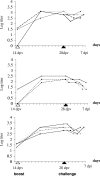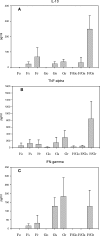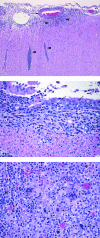Recombinant nipah virus vaccines protect pigs against challenge
- PMID: 16873250
- PMCID: PMC1563797
- DOI: 10.1128/JVI.00263-06
Recombinant nipah virus vaccines protect pigs against challenge
Abstract
Nipah virus (NiV), of the family Paramyxoviridae, was isolated in 1999 in Malaysia from a human fatality in an outbreak of severe human encephalitis, when human infections were linked to transmission of the virus from pigs. Consequently, a swine vaccine able to abolish virus shedding is of veterinary and human health interest. Canarypox virus-based vaccine vectors carrying the gene for NiV glycoprotein (ALVAC-G) or the fusion protein (ALVAC-F) were used to intramuscularly immunize four pigs per group, either with 10(8) PFU each or in combination. Pigs were boosted 14 days postvaccination and challenged with 2.5 x 10(5) PFU of NiV two weeks later. The combined ALVAC-F/G vaccine induced the highest levels of neutralization antibodies (2,560); despite the low neutralizing antibody levels in the F vaccinees (160), all vaccinated animals appeared to be protected against challenge. Virus was not isolated from the tissues of any of the vaccinated pigs postchallenge, and a real-time reverse transcription (RT)-PCR assay detected only small amounts of viral RNA in several samples. In challenge control pigs, virus was isolated from a number of tissues (10(4.4) PFU/g) or detected by real-time RT-PCR. Vaccination of the ALVAC-F/G vaccinees appeared to stimulate both type 1 and type 2 cytokine responses. Histopathological findings indicated that there was no enhancement of lesions in the vaccinees. No virus shedding was detected in vaccinated animals, in contrast to challenge control pigs, from which virus was isolated from the throat and nose (10(2.9) PFU/ml). Based on the data presented, the combined ALVAC-F/G vaccine appears to be a very promising vaccine candidate for swine.
Figures





References
-
- Audonnet, J. C., J. Minke, and H. Poulet. 2005. Veterinary applications of the canarypox vaccine vector technology—recent developments for vaccines in domestic mammalian species, p. 133-140. In P. Moingeon (ed.), Vaccines: frontiers in design and development. Horizon Scientific Press, Norfolk, United Kingdom.
-
- Belshe, R. B., C. Stevens, G. J. Gorse, S. Buchbinder, K. Weinhold, H. Sheppard, D. Stablein, S. Self, J. McNamara, S. Frey, J. Flores, J. L. Excler, M. Klein, R. E. Habib, A. M. Duliege, C. Harro, L. Corey, M. Keefer, M. Mulligan, P. Wright, C. Celum, F. Judson, K. Mayer, D. McKirnan, M. Marmor, G. Woody, and the National Institute of Allergy and Infectious Diseases AIDS Vaccine Evaluation Group, and the H.I.V. Network for Prevention Trials (HIVNET). 2001. Safety and immunogenicity of a canarypox-vectored human immunodeficiency virus type 1 vaccine with or without gp120: a phase 2 study in higher- and lower-risk volunteers. J. Infect. Dis. 183:1343-1352. - PubMed
-
- Berhane, Y., J. D. Berry, C. Ranadheera, P. Marszal, B. Nicolas, X. Yuan, M. Czub, and H. Weingartl. 2006. Production and characterization of monoclonal antibodies against binary ethylenimine inactivated Nipah virus. J. Virol. Methods 132:59-68. - PubMed
Publication types
MeSH terms
Substances
Grants and funding
LinkOut - more resources
Full Text Sources
Other Literature Sources

